Related Research Articles

Biological control or biocontrol is a method of controlling pests such as insects, mites, weeds and plant diseases using other organisms. It relies on predation, parasitism, herbivory, or other natural mechanisms, but typically also involves an active human management role. It can be an important component of integrated pest management (IPM) programs.

In evolutionary ecology, a parasitoid is an organism that lives in close association with its host at the host's expense, eventually resulting in the death of the host. Parasitoidism is one of six major evolutionary strategies within parasitism, distinguished by the fatal prognosis for the host, which makes the strategy close to predation.

The Tachinidae are a large and variable family of true flies within the insect order Diptera, with more than 8,200 known species and many more to be discovered. Over 1300 species have been described in North America alone. Insects in this family commonly are called tachinid flies or simply tachinids. As far as is known, they all are protelean parasitoids, or occasionally parasites, of arthropods, usually other insects. The family is known from many habitats in all zoogeographical regions and is especially diverse in South America.

The glassy-winged sharpshooter is a large leafhopper insect from the family Cicadellidae, similar to other species of sharpshooter.

A leafhopper is the common name for any species from the family Cicadellidae. These minute insects, colloquially known as hoppers, are plant feeders that suck plant sap from grass, shrubs, or trees. Their hind legs are modified for jumping, and are covered with hairs that facilitate the spreading of a secretion over their bodies that acts as a water repellent and carrier of pheromones. They undergo a partial metamorphosis, and have various host associations, varying from very generalized to very specific. Some species have a cosmopolitan distribution, or occur throughout the temperate and tropical regions. Some are pests or vectors of plant viruses and phytoplasmas. The family is distributed all over the world, and constitutes the second-largest hemipteran family, with at least 20,000 described species.

Brochosomes are intricately structured microscopic granules secreted by leafhoppers and typically found on their body surface and, more rarely, eggs. Brochosomes were first described in 1952 with the aid of an electron microscope. Brochosomes are hydrophobic and help keep the insect cuticle clean. These particles have also been found in samples of air and can easily contaminate foreign objects, which explains erroneous reports of brochosomes on other insects.

The Mymaridae, commonly known as fairyflies or fairy wasps, are a family of chalcidoid wasps found in temperate and tropical regions throughout the world. The family contains around 100 genera with 1400 species.
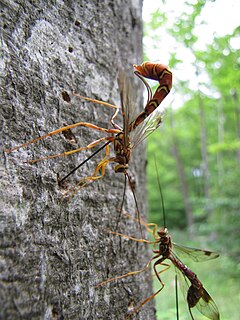
Parasitoid wasps are a large group of hymenopteran superfamilies, with all but the wood wasps (Orussoidea) being in the wasp-waisted Apocrita. As parasitoids, they lay their eggs on or in the bodies of other arthropods, sooner or later causing the death of these hosts. Different species specialise in hosts from different insect orders, most often Lepidoptera, though some select beetles, flies, or bugs; the spider wasps (Pompilidae) exclusively attack spiders.

Evaniidae is a family of parasitoid wasps also known as ensign wasps, nightshade wasps, hatchet wasps, or cockroach egg parasitoid wasps. They number around 20 extant genera containing over 400 described species, and are found all over the world except in the polar regions. The larvae of these solitary wasps are parasitoids that feed on cockroaches and develop inside the egg-cases, or oothecae, of their hosts.

Pseudococcus viburni is a close relative of the grape mealybug and a pest of the vineyards around the world.

A wasp is any insect of the narrow-waisted suborder Apocrita of the order Hymenoptera which is neither a bee nor an ant; this excludes the broad-waisted sawflies (Symphyta), which look somewhat like wasps, but are in a separate suborder. The wasps do not constitute a clade, a complete natural group with a single ancestor, as bees and ants are deeply nested within the wasps, having evolved from wasp ancestors. Wasps that are members of the clade Aculeata can sting their prey.
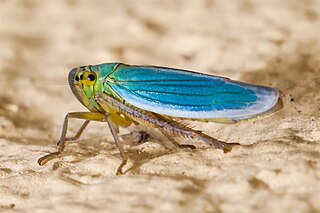
Cicadella viridis, the green leafhopper, is a species belonging to the subfamily Cicadellinae of the family Cicadellidae.
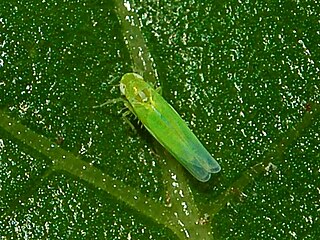
Empoasca decipiens is a species of leafhopper belonging to the family Cicadellidae subfamily Typhlocybinae. The adults reach 3–4 millimetres (0.12–0.16 in) of length and a are homogenously green with whitish markings on its pronotum and vertex. E. decipiens is commonly referred to as the “green leafhopper” because of its colouration. The absence of clear stripes along the forewings can easily distinguish it from the similar leafhopper species E. vitis, but distinguishing it from other leafhoppers with the same colouration requires examination under a microscope. It is present in most of Europe, in the eastern Palearctic realm, in North Africa, in the Near East, and in the Afrotropical realm. Both nymphs and adults of this small insect are considered to be a very destructive pests on field crops, vegetables and greenhouse plants.
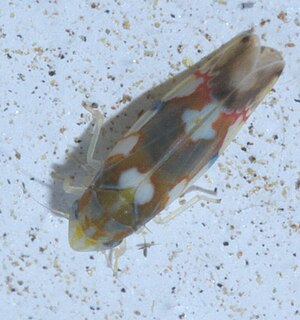
Erythroneura elegans is a species of leafhopper in the family Cicadellidae.
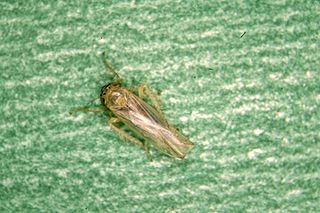
Macrosteles quadrilineatus, the aster leafhopper or six-spotted leafhopper, is a leafhopper species in the genus Macrosteles, found in the United States. It is the vector of aster yellows disease, which affects various vegetable plants, weeds and ornamental plants.
Gonatopus clavipes is a species of small wasp in the family Dryinidae. It is a solitary wasp that superficially resembles an ant, and its larva is a parasitoid of leafhoppers in the subfamily Deltocephalinae. It has a Palearctic distribution, and within Europe parasitises at least eleven genera and thirty-one species of leafhopper.
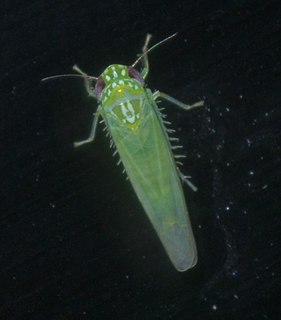
Empoasca fabae belongs to family Cicadellidae and genus Empoasca within order Hemiptera. They are more commonly referred to as the potato leafhopper. In North America they are a serious agricultural pest. Every year millions of dollars are lost from reduced crop yields and on pest management. Crops that are impacted the most are potatoes, clover, beans, apples and alfalfa.
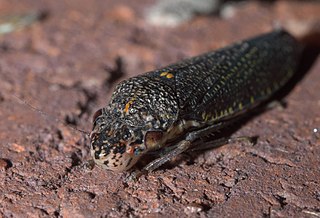
Paraulacizes irrorata, the speckled sharpshooter, is a species of sharpshooter in the family Cicadellidae.
Anagrus optabilis is a species of fairyfly. It is a parasitoid of Perkinsiella saccharicida.
References
- ↑ Hesami, Shahram; Seyedoleslami, Hossein; Ebadi, Rahim (2004). "Biology of Anagrus atomus (Hymenoptera: Mymaridae), an egg parasitoid of the grape leafhopper Arboridia kermanshah (Homoptera: Cicadellidae)". Entomological Science. 7 (3): 271–276. doi:10.1111/j.1479-8298.2004.00073.x. ISSN 1343-8786. S2CID 86503433 – via Wiley.